ANIMAL KINGDOM Notes 9th Science Lesson 17 Notes in English
ANIMAL KINGDOM
Introduction
- The variety of living organisms surrounding us is incomprehensible.
- Nearly 1.5 million species of organism which have been described are different from one another.
- The uniqueness is due to the diversity in the life forms whether it is microbes, plants or animals.
- Every organism exhibits variation in their external appearance, internal structure and behavior, mode of living etc.
- This versatile nature among the living animals forms the basis of diversity.
- The diversity among the living organisms can be studied in an effective way by arranging animals in an orderly and systematic manner.
- The study of various organisms would be difficult without a suitable method of classification.
- The method of arranging organism into groups on the basis of similarities and differences is called classification.
- Taxonomy is the science of classification which makes the study of wide variety of organisms easier.
- It helps us to understand the relationship among different group of animals.
- The first systematic approach to the classification of living organisms was made by a Swedish botanist, Carolus Linnaeus.
- He generated the standard system for naming organisms in terms of genus, species and more extensive groupings using Latin terms.
Classification of Living Organisms
- Classification is the ordering of organism into groups on the basis of their similarities, dissimilarities and relationships.
- The five kingdom classification are Monera, Protista, Fungi, Plantae and Animalia.
- These groups are formed based on cell structure, mode of nutrition, body organization and reproduction.
- On the basis of hierarchy of classification, the organisms are separated into smaller and smaller groups which form the basic unit of classification.
- Species: It is the lowest taxonomic category. For example, the large Indian parakeet (Psittacula eupatra) and the green parrot (Psittacula krameri) are two different species of birds.
- They belong to different species eupatra and krameri and cannot interbreed.
- Genus: It is a group of closely related species which constitute the next higher category called genus.
- For example, the Indian wolf (Canis pallipes) and the Indian jackal (Canis aures) are placed in the same genus Canis.
- Family: A group of genera with several common characters form a family. For example, leopard, tiger and cat share some common characteristics and belong to the larger cat family Felidae.
- Order: A number of related families having common characters are placed in an order.
- Monkeys, baboons, apes and Man although belong to different families, are placed in the same order Primates.
- Since all these animals possess some common features, they are placed in the same order.
- Class: Related or similar orders together form a class.
- The orders of different animals like those of rabbit, rat, bats, whales, chimpanzee and human share some common features such as the presence of skin and mammary glands.
- Hence, they are placed in class Mammalia.
- Phylum: Classes which are related with one another constitute a phylum.
- The classes of different animals like mammals, birds, reptiles, frogs and fishes constitute Phylum Chordata which have a notochord or back bone.
- Kingdom: It is the highest category and the largest division to which microorganisms, plants and animals belong to.
- Each kingdom is fundamentally different from one another, but has the same fundamental characteristics in all organisms grouped under that Kingdom.
- The taxa of living organisms are in a hierarchy of categories as follows.

Basis for Classification
- We can divide the Animal kingdom based on the level of organization (arrangement of cells), body symmetry, germ layers and nature of coelom.
- Level of organization: Animals are grouped as unicellular or multicellular based on cell, tissue, organ and organ system level of organization
- Symmetry: It is a plane of arrangement of body parts. Radial symmetry and bilateral symmetry are the two types of symmetry.
- In radial symmetry the body parts are arranged around the central axis.
- If the animal is cut through the central axis in any direction, it can be divided into similar halves. e.g. Hydra, jelly fish and star fish.
- In bilateral symmetry, the body parts are arranged along a central axis.
- If the animal is cut through the central axis, we get two identical halves e.g. Frog.
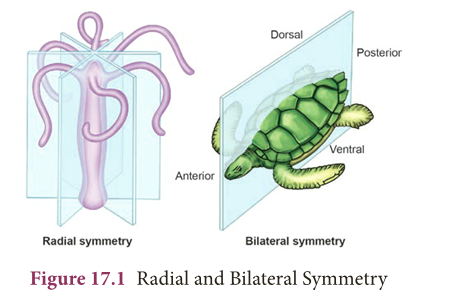
- Germ layers: Germ layers are formed during the development of an embryo.
- These layers give rise to different organs, as the embryo becomes an adult.
- Organisms with two germ layers, the ectoderm and the endoderm are called diploblastic animals. e.g Hydra.
- Organisms with three germ layers, ectoderm, mesoderm and endoderm are called triploblastic animals. e.g
- Rabbit Coelom: It is a fluid-filled body cavity. It separates the digestive tract from the body wall.
- A true body cavity or coelom is one that is located within the mesoderm.
- Based on the nature of the coelom, animals are divided into 3 groups.
- Acoelomates do not have a body cavity e.g Tapeworm.
- Pseudocoelomates have a false body cavity e.g Roundworm.
- Coelomates or Eucoelomates have a true coelom e.g Earthworm, Frog.
- Animal Kingdom is further divided into two groups based on the presence or absence of notochord as below.
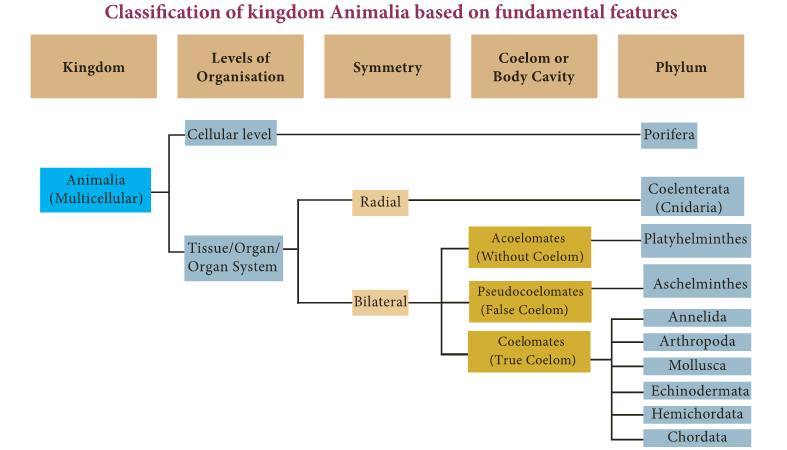
- Invertebrata
- Chordata-Prochordata and Vertebrata
- Animals which do not possess notochord are called as Invertebrates or Non- chordates.
- Animals which possess notochord or backbone are called as Chordates.
- You have already studied the characters of single celled protozoans.

Binomial Nomenclature
- Carolus Linnaeus introduced the method of naming the animals with two names known as binomial nomenclature.
- The first name is called genus and the first letter of genus is denoted in capital and the second one is the species name denoted in small letter.
- The binomial names of some common animals are as follows.
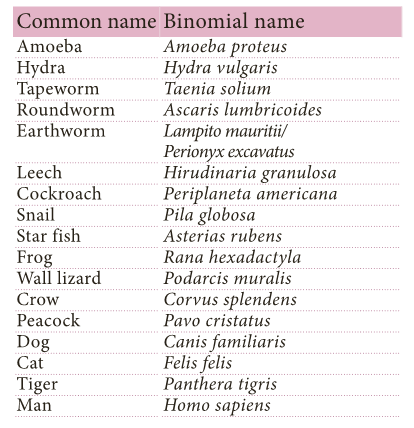
Invertebrata
Phylum Porifera (Pore bearers)
- These are multicellular, non-motile aquatic organisms, commonly called as sponges. They exhibit cellular grade of organization.
- Body is perforated with many pores called ostia.
- Water enters into the body through ostia and leads to a canal system.
- It circulates water throughout the body and carries food, oxygen.
- The body wall contains spicules, which form the skeletal framework.
- Reproduction is by both asexual and sexual methods. e.g- Euplectella, Sycon.

Phylum Coelenterata (Cnidaria)
- Coelenterates are aquatic organisms, mostly marine and few fresh water forms.
- They are multicellular, radially symmetrical animals, with tissue grade of organization.
- Body wall is diploblastic with two layers. An outer ectoderm and inner endoderm are separated by non- cellular jelly like substance called mesoglea.
- It has a central gastrovascular cavity called coelenteron with mouth surrounded by short tentacles.
- The tentacles bear stinging cells called cnidoblast or nematocyst.

- Many coelenterates exhibit polymorphism, which is the variation in the structure and function of the individuals of the same species.
- They reproduce both asexually and sexually. e.g. Hydra, Jellyfish.
Phylum Platyhelminthes (Flat worms)
- They are bilaterally symmetrical, triploblastic, acoelomate (without body cavity) animals.
- Most of them are parasitic in nature.
- Suckers and hooks help the animal to attach itself to the body of the host.
- Excretion occurs by specialized cells called flame cells.
- These worms are hermaphrodites having both male and female reproductive organs in a single individual. e.g- Liverfluke, Tapeworm.
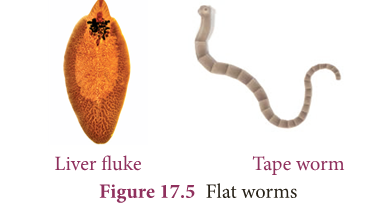
Phylum Aschelminthes (Round worms)
- Aschelminthes are bilaterally symmetrical, triploblastic animals.
- The body cavity is a pseudocoelom.
- They exist as free-living soil forms or as parasites.
- The body is round and pointed at both the ends. It is unsegmented and covered by thin cuticle. Sexes are separate.
- The most common diseases caused by nematodes in human beings are elephantiasis and ascariasis. e.g-Ascaris, Wuchereria.
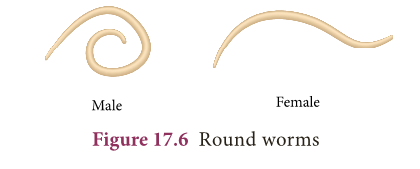
Phylum Annelida (Segmented worms)
- These are bilaterally symmetrical, triploblastic, first true coelomate animals with organ-system grade of organization.
- Body is externally divided into segments called metameres joined by ring like structures called annuli. It is covered by moist thin cuticle.
- Setae and parapodia are locomotor organs.
- Sexes may be separate or united (hermaphrodites). e.g- Nereis, Earthworm, Leech.
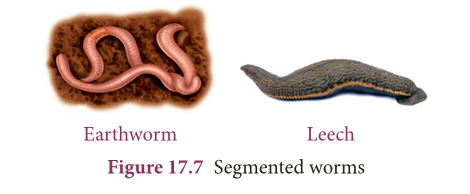
Phylum Arthropoda (Animals with jointed legs)
- Arthropoda is the largest phylum of the animal kingdom.
- They are bilaterally symmetrical, triploblastic and coelomate animals. The body is divisible into head, thorax and abdomen.
- Each thorasic segment bears paired jointed legs.
- Exoskeleton is made of chitin and is shed periodically as the animal grows. The casting off and regrowing of exoskeleton is called moulting.
- Body cavity is filled with haemolymph (blood).
- The blood does not flow in blood vessels and circulates throughout the body (open circulatory system).
- Respiration is through body surface, gills or tracheae (air tubes). Excretion occurs by malphigian tubules or green glands.
- Sexes are separate. E.g., Prawn, Crab, Cockroach, Millipede, Centipedes, Spider, Scorpion.
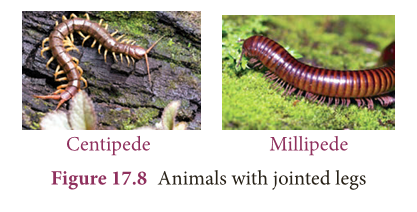
Phylum Mollusca (Soft Bodied Animals)
- They are diversified group of animals living in marine, fresh water and terrestrial habitats.
- Body is bilaterally symmetrical, soft and without segmentation.
- It is divided into head, muscular foot and visceral mass.
- The foot helps in locomotion. The entire body is covered with fold of thin skin called mantle, which secretes outer hard calcareous shell.
- Respiration is through gills (ctenidia) or lungs or both.
- Sexes are separate with larval stages during development. e.g-Garden snail, Octopus.
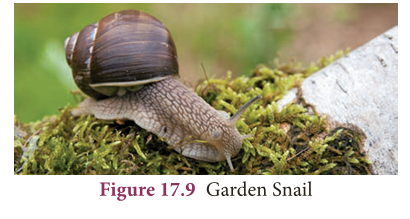
Phylum Echinodermata (Spiny Skinned Animals)
- They are exclusively free-living marine animals.
- These are triploblastic and true coelomates with organ-system grade of organization.
- Adult animals are radially symmetrical but larvae remain bilaterally symmetrical.
- A unique feature is the presence of fluid filled water vascular system.
- Locomotion occurs by tube feet.
- Body wall is covered with spiny hard calcareous ossicles.e.g- Star fish, Sea urchin.
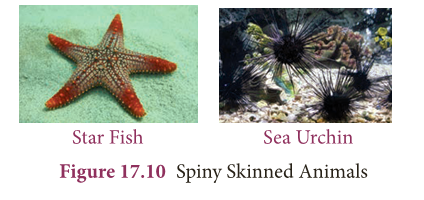
Phylum Hemichordata
- Hemichordates are marine organisms with soft, vermiform and unsegmented body.
- They are bilaterally symmetrical, coelomate animals with non-chordate and chordate features.
- They have gill slits but do not have notochord.
- They are ciliary feeders and mostly remain as tubiculous forms. E.g- Balanoglossus (Acorn worms).
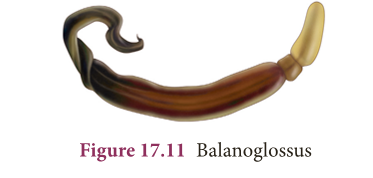
Chordata
- Chordates are characterized by the presence of notochord, dorsal nerve cord and paired gill pouches.
- Notochord is a long rod like support along the back of the animal separating the gut and nervous tissue.
- All chordates are triploblastic and coelomate animals.
- Phylum Chordata is divided into two groups: Prochordata and Vertebrata.
Prochordata
- The prochordates are considered as the forerunners of vertebrates.
- Based on the nature of the notochord, prochordata is classified into subphylum Urochordata and subphylum Cephalochordata.
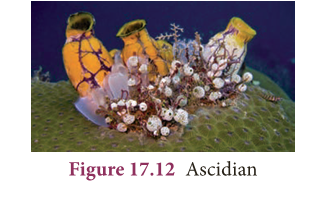
Subphylum Urochordata
- Notochord is present only in the tail region of free-living larva. Adults are sessile forms and mostly degenerate.
- The body is covered with a tunic or test. e.g. Ascidian
Subphylum Cephalochordata
- Cephalochordates are small fish like marine chordates with unpaired dorsal fins.
- The notochord extends throughout the entire length of the body. E.g. Amphioxus

Vertebrata
- This group is characterized by the presence of vertebral column or backbone.
- Notochord in an embryonic stage gets replaced by the vertebral column, which forms the chief skeletal axis of the body.
- Vertebrata are grouped into six classes.
Class: Cyclostomata
- Cyclostomes are jawless vertebrates (mouth not bounded by jaws).
- Body is elongated and eel like. They have circular mouth.
- Skin is slimy and scaleless.
- They are ectoparasites of fishes. E.g. Hagfish.
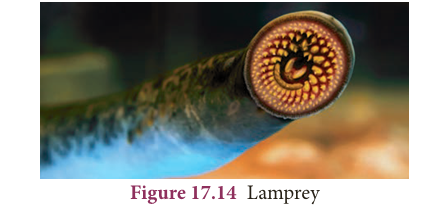
Class: Pisces
- Fishes are poikilothermic (cold-blooded), aquatic vertebrates with jaws.
- The streamlined body is divisible into head, trunk and tail.
- Locomotion is by paired and median fins. Their body is covered with scales.
- Respiration is through gills.
- The heart is two chambered with an auricle and a ventricle.
- There are two main types of fishes.
- Cartilaginous fishes, with skeleton made of cartilages e.g. Sharks, Skates.
- Bony fishes with skeleton made of bones e.g. Carps, Mullets.
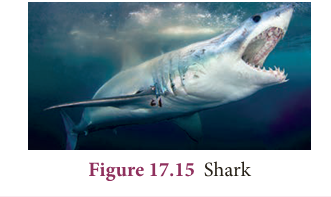
Class: Amphibia (amphi- both; bios- life)
- These are the first four legged (tetrapods) vertebrates with dual adaptation to live in both land and water.
- The body is divisible into head and trunk.
- Their skin is moist and have mucus glands.
- Respiration is through gills, lungs, skin or buccopharynx.
- The heart is three chambered with two auricles and one ventricle.
- Eggs are laid in water.
- The tadpole larva, transforms into an adult. e.g-Frog, Toad.
Class: Reptilia (repere- to crawl or creep)
- These vertebrates are fully adapted to live on land.
- Their body is covered with horny epidermal scales.
- Respiration is through lungs.
- The heart is three chambered with an exemption of crocodiles, which have four-chambered heart.
- Most of the reptiles lay their eggs with tough outer shell e.g Calotes, Lizard, Snake, Tortoise, Turtle.
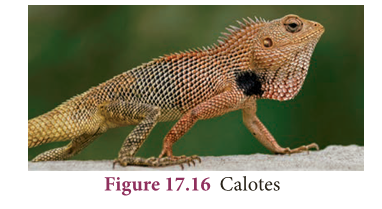
Class: Aves (avis – bird)
- Birds are homeothermic (warm- blooded) animals with several adaptations to fly.
- The spindle or boat shaped body is divisible into head, neck, trunk and tail.
- The body is covered with feathers.
- Forelimbs are modified into wings for flight.
- Hindlimbs are adapted for walking, perching or swimming.
- The respiration is through lungs, which have air sacs.
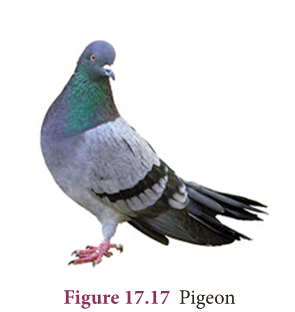
- Bones are filled with air (pneumatic bones), which reduces the body weight.
- They lay large yolk laden eggs.
- They are covered by hard calcareous shell. e.g. Parrot, Crow, Eagle, Pigeon, Ostrich .

Class: Mammalia (mamma-breast)
- Mammals are warm-blooded animals.
- The skin is covered with hairs. It also bears sweat and sebaceous (oil) glands.
- The body is divisible into head, neck, trunk and tail.
- Females have mammary glands, which secrete milk for feeding the young ones.
- The external ears or pinnae is present.
- Heart is four chambered and they breathe through lungs.
- Except egg laying mammals (Platypus, and Spiny anteater), all other mammals give birth to their young ones (viviparous).
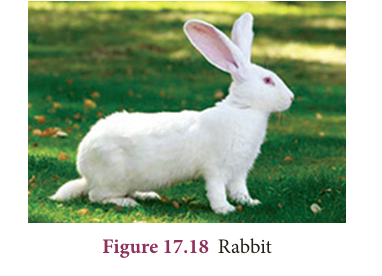
- Placenta is the unique characteristic feature of mammals.e.g Rat, Rabbit, Man.
More to Know
Notochord
- Notochord is a rod like structure formed on the mid-dorsal side of the body during embryonic development.
- Except primitive forms in which the notochord persists throughout life in all other animals it is replaced by a backbone.
Centipede
- Centipede means ‘hundred legs’.
- But most species have only 30 pairs.
- Millipedes have two pairs of legs on each segment.
- This name means ‘thousand legs’. But, most millipedes have only about a hundred.
Octopus
- Octopus is the only invertebrate that is capable of emotion, empathy, cognitive function, self awareness, personality and even relationships with humans.
- Some speculate that without humans, octopus would eventually take our place as the dominate life form on earth.
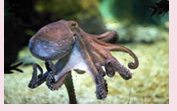
Philippine goby

- The smallest vertebrate, Philippine goby/dwarf pygmy goby is a tropical species fish found in brackish water and mangrove areas in south East Asia, measuring only 10 mm in length.
The Chinese giant salamander

- Andrias davidians is the largest amphibian in the world.
- Its length is about five feet and eleven inches.
- It weighs about 65 kg, found in Central and South China.
State bird

- State bird of Tamil Nadu Common Emerald dove. (Chalcophaps indica)
Blue whale

- The gigantic Blue whale which is 35 meters long and 120 tons in weight is the biggest vertebrate animal.
EXTRA POINTS:
- Acoelomates: Animals which do not have a body cavity.
- Amphibian: Cold-blooded vertebrate animal of a class that comprises the frogs, toads, newts, salamanders.
- Annelida: Phylum that comprises the segmented worms which include earthworms and leeches.
- Aves: Vertebrates which comprises the birds.
- Coelomates: Animals which have a true coelom e.g Earthworm, Frog.
- Classification: Arrangement of groups of animals, the members of which have one or more characteristics in common.
- Mammals: Warm-blooded vertebrate animals that possess hairs, mammary glands and feed their young ones.
- Pseudocoleomates: False body cavity which is not bounded by true epithelial lining. e.g Roundworm
- Toads: Anurans with smooth skin than that of frogs, terrestrial and leap rather than jump.
